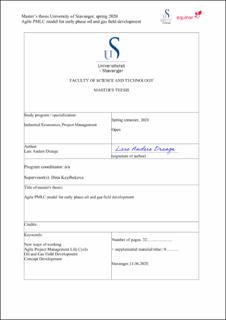| dc.contributor.advisor | Kayrbekova, Dina | |
| dc.contributor.author | Drange, Lars Anders | |
| dc.coverage.spatial | Norway | en_US |
| dc.date.accessioned | 2020-10-12T09:33:03Z | |
| dc.date.available | 2020-10-12T09:33:03Z | |
| dc.date.issued | 2020-06-14 | |
| dc.identifier.uri | https://hdl.handle.net/11250/2682169 | |
| dc.description | Master's thesis in Industrial Economics | en_US |
| dc.description.abstract | This master’s thesis explores a new way of working in early phase oil and gas field development projects by developing an agile PMLC model for concept development for field development project and for unmanned concept facility design.
Use of the agile model for field development project makes it easier to identify the most optimum concept, delivering reduced cost and increased quality. Identification of the optimum concept with a minimum amount of resources is critical for the future of the oil and gas industry, with low oil prices, increased competition and a strong focus on sustainability. The proposed agile PMLC is to be set up so that iterations, or cycles, can be performed on the complete business case as early as possible. The project should develop a Minimum Viable Product concept early on and then perform iterations on the overall business case. This will ensure that global project KPIs are optimized and energy is spent on improving the areas with the biggest impact, thereby avoiding sub-optimization and waste. The approach requires an innovative approach and specific attention to the PMI knowledge areas of integration, scope, HR and communication management across the project. Systems and tools to effectively manage these knowledge areas are developed in detail as part of this work.
Several challenges have been identified for implementation of the agile PMLC model. Most of these relate to the complex nature and size of oil and gas field developments. Ways of effectively managing change, communication and interfaces will be critical in order to expand the typical team size for agile projects. A digital tool known as a Business Case Simulator is outlined in this thesis in order to mitigate some of that risk by enabling effective communication of basis of design, changes and monitoring of KPIs.
The potential of the agile model has been proven through literature study and personal experience, but further work is needed to mature the model further, including supporting tools and verification of the potential through implementation in a project. Due to time and budget limitations it has not been possible to verify the agile PMLC model as part of this thesis, however, based on discussions with senior project managers at Equinor is it likely that it will succeed. This thesis forms the basis for further work that is necessary to establish a strong foundation for the broad implementation of agile PMLC in early phase oil and gas projects. A stepwise approach is suggested for implementation at Equinor, with a pilot on a small greenfield project in order to test the model, develop contract strategies appropriate for agile models and acquire knowledge for further improvements.
Developing and designing an unmanned and remote operated facility set high requirements to optimum solutions designed for maximum operability. An agile PMLC model for facility design has been developed in order to ensure high degree of user involvement in design, which is key in order to identify the optimum unmanned solutions. The principles of such a model have been developed in Equinor during the last years and referred to as Design-2-Operate process. The agile iterative model as described in this thesis are my work based on those principles. Key principles are co-management of design between facility and operations, based on iterative design process where main operability KPI’s are reviewed at end of each iterations forming the basis for prioritization of tasks in the iteration. This agile model is ready for implementation in concept studies for an unmanned facility project. | en_US |
| dc.language.iso | eng | en_US |
| dc.publisher | University of Stavanger, Norway | en_US |
| dc.relation.ispartofseries | Masteroppgave/UIS-TN-ISØP/2020; | |
| dc.rights | Attribution-NonCommercial-NoDerivatives 4.0 Internasjonal | * |
| dc.rights.uri | http://creativecommons.org/licenses/by-nc-nd/4.0/deed.no | * |
| dc.subject | oil and gas field development | en_US |
| dc.subject | industriell økonomi | en_US |
| dc.subject | agile | en_US |
| dc.title | Agile PMLC model for early phase oil and gas field development | en_US |
| dc.type | Master thesis | en_US |
| dc.description.version | submittedVersion | en_US |
| dc.subject.nsi | VDP::Samfunnsvitenskap: 200::Økonomi: 210 | en_US |
| dc.subject.nsi | VDP::Teknologi: 500 | en_US |
| dc.source.pagenumber | 32 | en_US |

